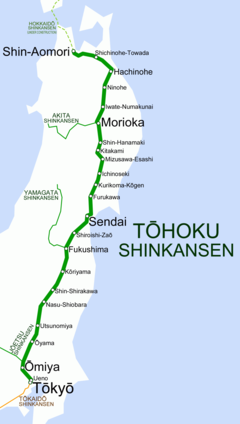Tōhoku Shinkansen
| Tōhoku Shinkansen | |||
|---|---|---|---|
 E5 series shinkansen on a Hayabusa service, March 2011 | |||
| Overview | |||
| Owner | JR East | ||
| Locale | Japan | ||
| Termini | |||
| Stations | 23 | ||
| Service | |||
| Type | Shinkansen | ||
| Depot(s) | Tokyo, Sendai, Morioka | ||
| History | |||
| Opened | 23 June 1982 | ||
| Technical | |||
| Line length | 674.9 km | ||
| Track gauge | 1435 | ||
| Operating speed | 300 km/h (185 mph)* | ||
| |||
The Tōhoku Shinkansen (東北新幹線) is a Japanese high-speed Shinkansen rail line, connecting Tokyo with Aomori in Aomori Prefecture for a total length of 674 km, Japan's longest Shinkansen line. It runs through the more sparsely populated Tōhoku region of Japan's main island Honshu. It has two spur lines, Yamagata Shinkansen and Akita Shinkansen. The line is operated by East Japan Railway Company (JR East).
Services
There are currently four services in operation:
- Hayabusa, Tokyo - Shin-Aomori limited-stop, starting 5 March 2011
- Hayate, Tokyo - Shin-Aomori limited-stop, starting December 2002
- Yamabiko, Tokyo - Sendai limited-stop, and all-stations to Morioka, starting June 1982
- Nasuno, Tokyo-Kōriyama all-stations, starting 1995
One service has been discontinued:
- Aoba, Tokyo - Sendai all-stations, June 1982 - October 1997 (consolidated with Nasuno)
Through trains on the Akita Shinkansen and Yamagata Shinkansen lines also run on Tōhoku Shinkansen tracks from Morioka and Fukushima respectively.
As of 5 March 2011, the maximum line speed is 110 km/h between Tokyo and Ōmiya, 275 km/h between Ōmiya and Utsunomiya, 300 km/h between Utsunomiya and Morioka, and 260 km/h between Morioka and Shin-Aomori.[1] The line speed will be further increased to 320 km/h between Utsunomiya and Morioka from early 2013.[2]
List of stations
History
- 28 November 1971: Construction starts on line.
- 23 June 1982: Ōmiya-Morioka section opens.
- 14 March 1985: Ueno-Ōmiya section opens.
- 20 June 1991: Tokyo-Ueno section opens.
- October 1998: 1 billionth passenger carried on Tōhoku, Jōetsu and Nagano Shinkansen lines.
- 1 December 2002: Morioka-Hachinohe section opens.
- 13 April 2010: Test running starts on extension from Hachinohe to Shin-Aomori.[3]
- 4 December 2010: The extension from Hachinohe to Shin-Aomori opens.[4]
- 5 March 2011: New Hayabusa services operating at 300 km/h commence operation between Tokyo and Shin-Aomori using new E5 series trainsets.[5]
From Aomori, construction is underway to continue the line under the name Hokkaido Shinkansen, passing through the world's longest railway tunnel, the Seikan Tunnel to Shin-Hakodate in Hokkaido, and eventually all the way to Sapporo.
The mountainous terrain that the line passes through has necessitated heavy reliance on tunnels. The Iwate-Ichinohe Tunnel on the Morioka-Hachinohe stretch, completed in 2000, was briefly the world's longest land rail tunnel at 25.8 km, but in 2005 it was superseded by the Hakkōda Tunnel on the extension to Aomori, at 26.5 km. The Lötschberg Base Tunnel and the Gotthard Base Tunnel in Switzerland have now superseded both.
Tōhoku earthquake and tsunami
On the afternoon of March 11, 2011, services on the Tōhoku Shinkansen were suspended as a result of the Tōhoku earthquake and tsunami. JR East estimated that around 1,100 repairs would be required for the line between Omiya and Iwate-Numakunai, ranging from collapsed station roofs to bent power pylons.[6]
Limited service on the line was being restored in segments: Tokyo to Nasu-Shiobara was re-opened on March 15, and Morioka to Shin-Aomori was re-opened on March 22.[7] The line between Morioka and Ichinoseki re-opened on April 7, Nasu-Shiobara and Fukushima on April 12, and the rest of the line on or around April 30, although not at full speed or a full schedule.[8][9][10] The trains returned to full-speed operations on 23 September 2011.[11]
Rolling stock

As of November 2011, the following types are used on Tōhoku Shinkansen services.
- E2 series: Hayate / Yamabiko / Nasuno services
- E3 series: Komachi / Tsubasa / Yamabiko / Nasuno services
- E4 series: Max Yamabiko / Max Nasuno services
- E5 series: Hayabusa / Hayate / Yamabiko services
- E6 series: Komachi services (from March 2013)
Types no longer used
- 200 series: Yamabiko / Nasuno services (1982 – November 2011)[12]
- 400 series: Tsubasa / Nasuno services
- E1 series: Max Yamabiko services (July 1994–December 1999)
Non-revenue-earning types
References
- JR Timetable, December 2008
- ^ "300km/hのトップランナー". Japan Railfan Magazine. 52 (612). Japan: Kōyūsha Co., Ltd.: p.14 April 2012.
{{cite journal}}:|page=has extra text (help); Unknown parameter|trans_title=ignored (|trans-title=suggested) (help) - ^ JR East press release: "東北新幹線八戸~新青森間の開業時期について" (10 November 2008). Retrieved on 11 November 2008. Template:Ja icon
- ^ "4月から八戸・新青森間で試験走行開始" (3 February 2010). Retrieved 3 February 2010. Template:Ja icon
- ^ "東北新幹線 新青森開業等について (Opening of Tōhoku Shinkansen to Shin-Aomori)" (PDF) (in Japanese). JR East. 11 May 2010. Retrieved 11 May 2010.
- ^ "新しい東北新幹線の列車愛称等の決定について (Name selected for new Tōhoku Shinkansen services)" (PDF) (in Japanese). JR East. 11 May 2010. Retrieved 11 May 2010.
- ^ http://headlines.yahoo.co.jp/videonews/jnn?a=20110318-00000001-jnn-soci
- ^ http://headlines.yahoo.co.jp/hl?a=20110322-00000124-yom-soci
- ^ "東日本大震災:東北新幹線、7日に盛岡-一ノ関間運転再開". Mainichi Shimbun. 4 April 2011. Retrieved 4 April 2011.
- ^ Kyodo News, "Tohoku Shinkansen to resume services on more sections", 12 April 2011.
- ^ NHK, "Tohoku Shinkansen to fully resume April 30", 18 April 2011.
- ^ Kyodo News, "Tohoku Shinkansen Line back to normal", Japan Times, 24 September 2011, p. 2.
- ^ "東北新幹線:はやてにもE5系 200系は姿消す". Mainichi.jp (in Japanese). Japan: The Mainichi Newspapers. 12 September 2011. Retrieved 12 September 2011.
{{cite web}}: Unknown parameter|trans_title=ignored (|trans-title=suggested) (help)
External links





